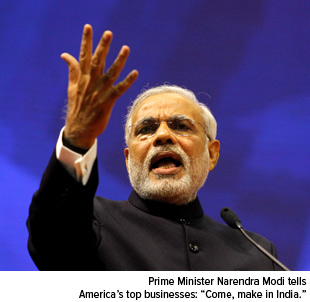
In the wake of his rock star reception at Madison Square Garden on Sept. 28, Indian Prime Minister Narendra Modi emphatically announced to our nation's top corporate and political leaders that India is now open for business.
Between Sept. 26 and 30, he met with not only U.S. President Barack Obama and other high-profile politicians, but also the chief executive officers of some of our nation's largest and most successful companies: Google Inc. (Nasdaq: GOOG, GOOGL), The Boeing Co. (NYSE: BA), PepsiCo Inc. (NYSE:
PEP), and General Electric Co. (NYSE:
GE), among others.
The only thing missing was a ribbon-cutting ceremony.
Although U.S. Global Investors Inc. typically doesn't invest in India, the country has recently found itself in the driver's seat of global resources demand and production. This is a tailwind for our Global Resources Fund (MUTF: PSPFX), which maintains heavy exposure in the industries that India will increasingly need to support its more than 1.25 billion (and counting) citizens: oil and gas, chemicals, energy services and infrastructure, precious metals, and food.
India's culture is ancient, dating back more than five millennia, but it has a disproportionately young population. As the world's second-most populous country, India is home to roughly 600 million people under the age of 25.
That's close to half of its own population and a little less than twice the entire U.S. population. Over the next few years, this one generation will largely be responsible for charting the country's trajectory into its next stage of economic development.
As old as India's culture is, millions of its citizens seek the contemporary American dream of opportunity and prosperity. And they rely on their new leader, former tea merchant Narendra Modi, as their ambassador of "hope for change," as he put it in his Sept. 25 op-ed in The Wall Street Journal.
Here's how Modi plans to deliver on this promise...
India Opening Its Wallet to International Sellers
At its current rate of population growth, the South Asian country will be in need of biblical amounts of natural resources in the coming years to meet the ambitious economic and social plans the newly elected prime minister has laid out.
Among other goals, Modi envisions "affordable healthcare within everyone's reach; sanitation for all by 2019; a roof over every head by 2022; electricity for every household; and connectivity to every village."
The energy infrastructure alone will require staggering amounts of copper conductors, iron, electrical steel, and oil. As I wrote back in May in my Frank Talk Blog, Modi has a proven track record for bringing electricity to Indians who previously never had it.
The prime minister also asserts: "The number of cell phones in India has gone up from about 40 million to more than 900 million in a decade; our country is already the second-largest market for smartphones, with sales growing ever faster." (China is currently the world's largest smartphone market.)
Most smartphones require a combination of many precious metals, minerals, and other materials, including gold, aluminum, glass, steel, lithium, and various rare earth elements you might never have heard of, such as yttrium, praseodymium, and dysprosium.
Since Modi's election in late May, the consumer outlook index in India has risen nearly 8%. At 45.2, however, it's still about five points shy of 50, the pivotal threshold that indicates, on balance, that more consumers perceive the economy to be improving.
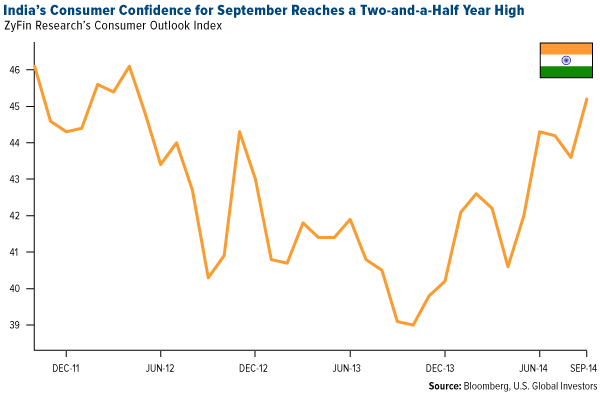
Planes, Trains, and Automobiles
As population mounts and business and manufacturing activity increases, India's need for additional cars and trucks has accelerated this year. Vehicle production uses not only many of the materials already mentioned, but also palladium, lead, zinc, and others.
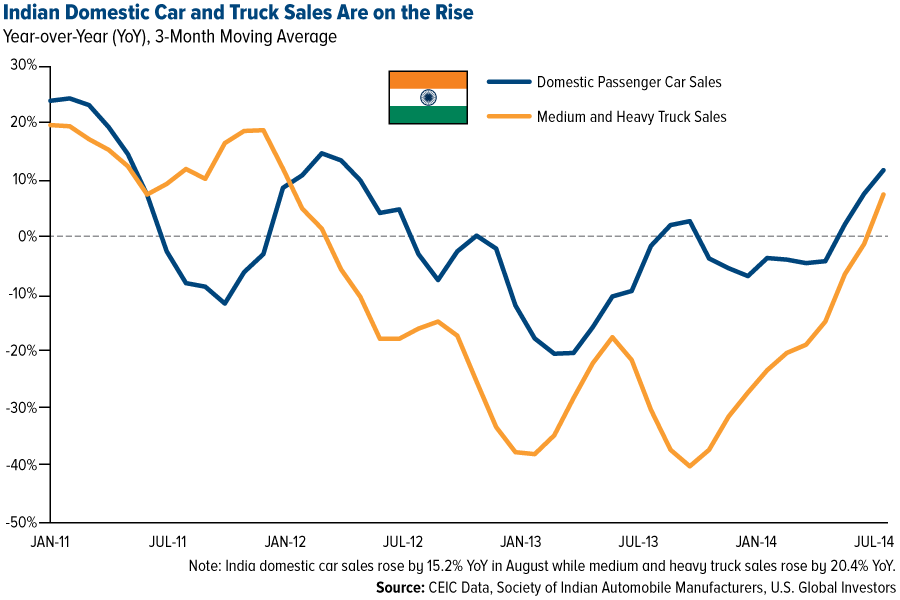
India, the world's largest importer of weapons, also has its eyes on American-made military aircraft - more than $3 billion worth. The Asian country is already the United States' leading defense market, and companies such as The Boeing Co., Lockheed Martin Corp. (NYSE:
LMT), and Sikorsky Aircraft Corp. (a United Technologies Corp. [NYSE: UTX] company) are no doubt pleased to hear that Modi's government is committed to ramping up its defense spending.
According to The Wall Street Journal,among the possible purchases Prime Minister Modi discussed during his visit to the United States were 22 Apache attack helicopters, 15 Chinook heavy-lift helicopters, and 24 Harpoon anti-ship missiles.
Investing in India: Going Long
Many economists and pundits have already likened Prime Minister Modi's transformative pro-business position to that of Ronald Reagan and Margaret Thatcher - and his media darling status to that of Barack Obama circa 2008.
Even before Modi's election, India was drawing the attention of global investors seeking growth and opportunity. Last month the portfolio manager of our China Region Fund (MUTF: USCOX), Xian Liang, had the pleasure to attend a presentation in Hong Kong by CLSA's Chris Wood, recognized as the one of the best strategists in Asian markets. During his speech, Wood maintained that India has been and continues to be his favorite market in the region, now more than ever since Modi's ascent:
"I have, in fact, allocated 41% of my long-only portfolio to India... I am not going to pull out because I am viewing India as a five-year story given the fact that Modi has been elected for five years. Modi is the most pro-business, pro-investment political leader in the world today."
Wood went on to argue that among the four BRIC countries - Brazil, Russia, and China included - India is the best place for investors to be right now.
But with Brazil's economy limping along at less than a 1% growth rate and Russia's wounded by international sanctions, it's hardly an intellectual feat to declare India the BRIC country with the greatest potential.
The chart below places India in context with other emerging Asian countries. As you can see, whereas the economies of China, Indonesia, and the Philippines are flat or slowing, India's is growing rapidly and projected to have a 7.2% growth rate by 2016, a 60% jump since 2012.
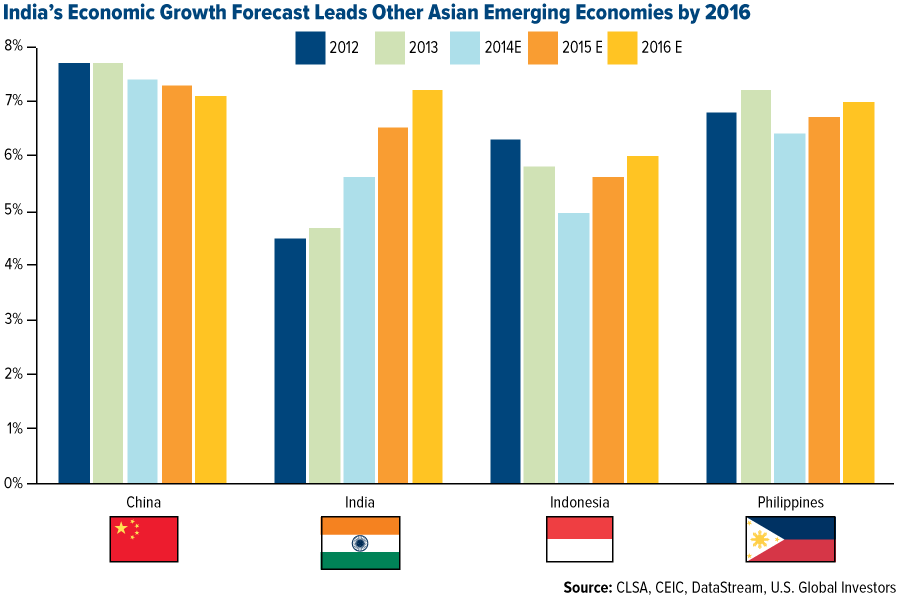
With Modi actively seeking partnerships with some of America's largest companies, it appears more and more likely that India can realize this optimistic growth rate.
The Challenges Ahead
Despite all of the good news, India faces many economic and political challenges that must be overcome before it can truly take off and achieve legitimate powerhouse status. According to the World Bank Group, the country ranks 134th in its Ease of Doing Business 2014 Rank, just below Yemen and Uganda. And out of 144 countries, India ranks 71st in the World Economic Forum's recently released Global Competitiveness Report 2014-2015, scoring 4.21 out of 7.
Tortuous trade barriers, which Modi has expressed his resolve to liberalize, still hinder constructive international business dealings. Gold import duties remain in effect, which has allegedly led to an increase in smuggling.
Also, although India's manufacturing sector in September showed modest growth for the eleventh consecutive month, the pace at which it grew is the slowest we've seen since December 2013. For the first time since March, the one-month moving average for the country's purchasing managers' index (PMI) crossed below the three-month moving average. This move contributed to the J.P. Morgan Global Manufacturing PMI's recent cross below the three-month, which, as I discussed recently in my Frank Talk Blog, could be a headwind for commodities and commodity stocks.
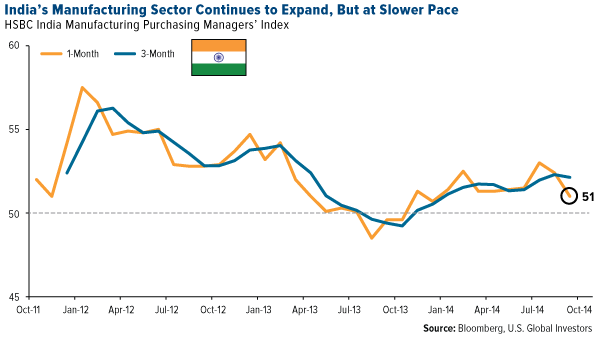
But such challenges don't appear to daunt the new prime minister.
"India is going to march ahead at a very fast pace," Modi told his nearly 20,000 attendees at Madison Square Garden on Sept. 28. "The twenty-first century will be that of India. By 2020, only India will be in a position to provide workforce to the world."
We at U.S. Global Investors wish Prime Minister Modi, his new government, and the 1.25 billion Indians all the best.
[Editor's Note: Frank Holmes is chief executive officer and chief investment officer of U.S. Global Investors Inc., which manages a diversified family of mutual funds and hedge funds specializing in natural resources, emerging markets, and infrastructure. He has been profiled by Fortune, Barron's, the Financial Times, and other publications. If you want commentary and analysis from Holmes and the rest of the U.S. Global Investors team delivered to your inbox every Friday, sign up to receive the weekly Investor Alert at www.usfunds.com.]
Next: Most investors haven't got a clue about what Hong Kong's riots represent, let alone the investment potential that's being unleashed there. Here's the hidden profit opportunity in Hong Kong's unrest...
Related Articles:
- The Wall Street Journal: An Invitation to "Make in India"
- U.S. Global Investors: Frank Talk Blog: It's Morning in India: Narendra Modi's Pro-Business Policies Point to Strong Sectors Growth
- The Wall Street Journal: Defense Deals Likely on Agenda as India's Modi Visits U.S.
- The Economic Times: India My Favourite Market in Asia, Since Modi Was Elected: Chris Wood, CLSA
- U.S. Global Investors: Frank Talk Blog: China Defies Analysts' Predictions with an Encouraging PMI
[epom key="ddec3ef33420ef7c9964a4695c349764" redirect="" sourceid=""]


